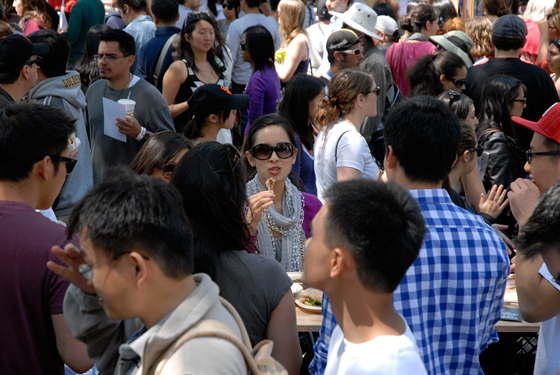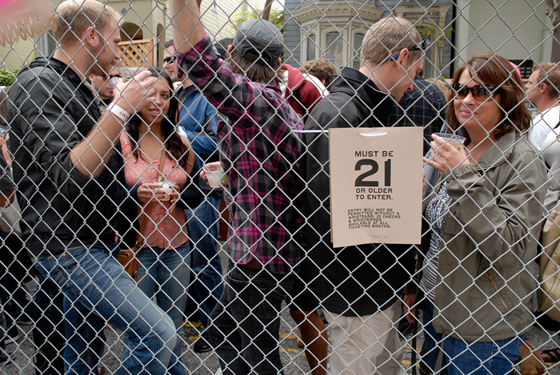
The Chaac Mool crew making tortillas for the day.
And that folks is what this street food celebration is really all about, as far as La Cocina executive director Caleb Zigas is concerned. "For many of the people we work with, serving street food is the only avenue afforded them to make a living," said Zigas, who led a pre-event press tour of vendors on Saturday. "It's a gateway to running a brick-and-mortar business."
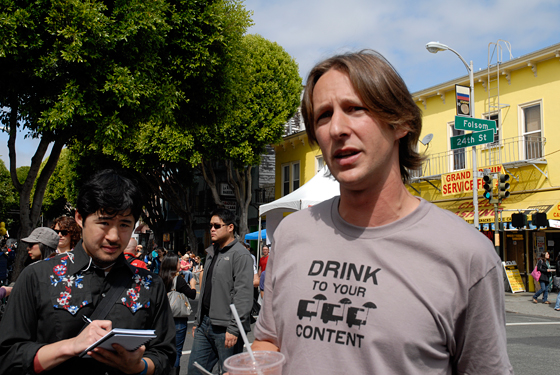
Francis Lam listens up during Caleb Zigas' media tour at the festival.
Food writer Francis Lam agreed. Lam is in town from New York to talk mobile food matters at the National Street Food Conference, which ends today at Fort Mason Center. He attended Saturday's festivities to get his fill of SF curbside chow like everyone else. (The man is seriously in love with local fruit too. He showed up at the media walk-through clutching a baggie holding two perfect plums. Breakfast.)
For consumers, street eats can signal an exotic outing, an edible adventure, or a search for authentic food, noted Lam, an editor at Gilt Taste, who has covered the mobile food phenomenon in previous gigs with Salon and Gourmet. But for the vendors, selling street food may not be something they've dreamed of doing all their life, it may be the only work they can do to survive, he said.
Part of the appeal of street food, Lam added, is that it's really home cooking --not fancy-pants restaurant cuisine or food served up as entertainment -- taken out of the intimacy of the home setting into the public sphere, where consumers can interact directly with the people who make it (not to mention folks in line to order.)
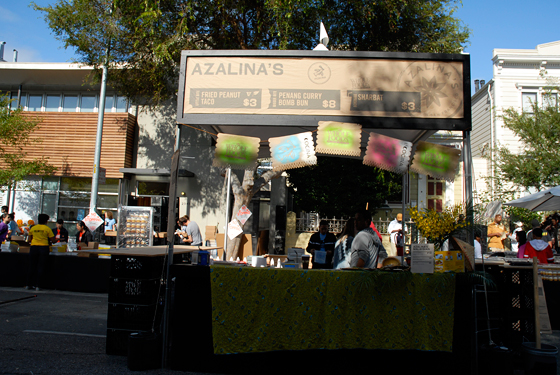
Azalina's Curry Bomb Buns proved popular at the street food festival.
Case in point: Fifth generation street eats seller Azalina Eusope. From Penang, Malaysia, Eusope knew mobile food was a tough way to make money and longed to be a lawyer but couldn't afford to go to law school. The legal profession's loss is the culinary world's gain: Eusope won a scholarship to attend cooking school at Raffles Hotel in Singapore, before finding her way to San Francisco, where her spicy street eats and sweet end notes earn rave reviews.
Cookbook author and Saveur contributor Andrea Nguyen summed up street eats in 5 Cs at Sunday's conference panel on writing about street food. Think cuisine, culture, craftsmanship, community and conversation -- to which I would add cash (for vendors) and cheap (for consumers). An aside: People will turn out in the thousands to nosh on curbside chow for under 8 dollars. But when asked to plunk down 50 bucks to hear experts weigh in on the subject on a Sunday afternoon there were far fewer takers.
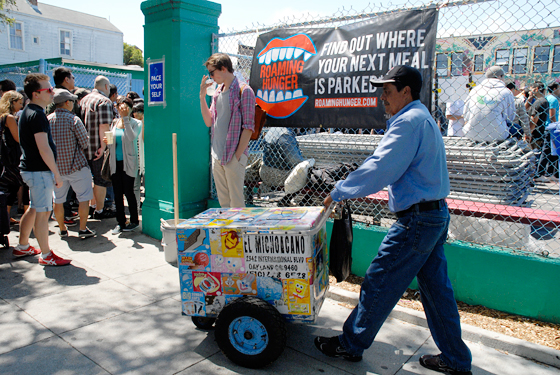
An under-the-social-media-radar street food vendor.
There was talk at the conference too (suspect more today on this matter) about the growing tension between old-time roving food vendors, often immigrants with no access to social media networks, being displaced by the D.I.Y., Twitter-savvy, younger generation of food hawkers, who enter into the nomadic food world with business plans, financial backing and role models.
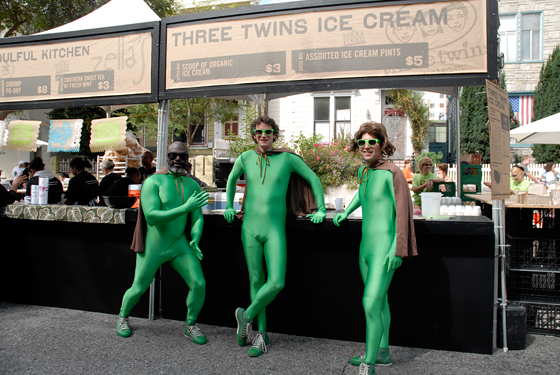
The Twitterific crowd include purveyors like the Three Twins Ice Cream guys.
As for the festival itself: For those grumbling about the presence of brick-and-mortar businesses like Out the Door, Flour + Water, Commonwealth, Osha, and Beretta, Zigas was quick to note that all came from modest, start-up backgrounds and were included in the mix because they represent success stories newcomers can aspire to, whether it's Charlie Phan's family-run restaurant empire, which includes Out the Door, or the sisters who started the growing Osha chain.

Osha Thai Restaurant crew ready to serve the masses on Saturday.
The downside of the day: Can this reporter state for the record that she doesn't believe in standing in long queues in hot sun waiting to sample global grub on the go, no matter how transformative and tasty these morsels may be? She may well be in the minority on that matter, given the snaking lines for sweet potato waffles at Pinx. Impressive lines formed for arepas, a kind of corn pancake, from The Arepa Lady, a former Colombian judge named Maria Piedad Cano who is something of a street eats legend in New York. Ditto at many, many other food booths.
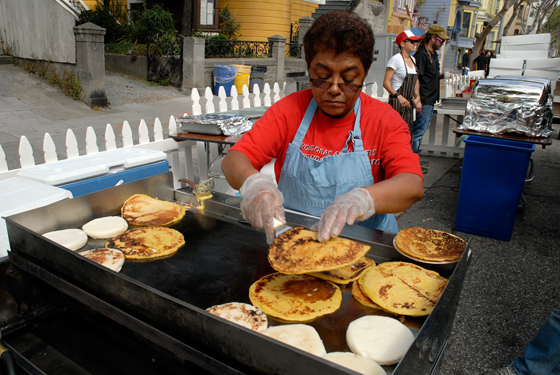
The Arepa Lady - Maria Piedad Cano of New York City - one of six visiting vendors on the day.
Still, this writer would much rather roll up to a truck's regular spot or stumble upon a cart somewhere new and find something satisfying to eat without having to queue like some half-starved Soviet in a bread line. Just saying.
A long line, too, to secure pre-ordered passports: What's with that? In the Internet age folks should be able to show up with tix in hand, not wait on the day, surely. But I'd been warned and warned readers too about the need to queue for food and folks who attended the previous two festivals (deemed a bit messy even by Zigas) agreed that things ran more smoothly last Saturday. Still, the area got so congested by mid-afternoon (crowd estimates around the 50,000 mark for the day's event) that organizers are toying with a Mission Bay location for future events, SFoodie reports today.
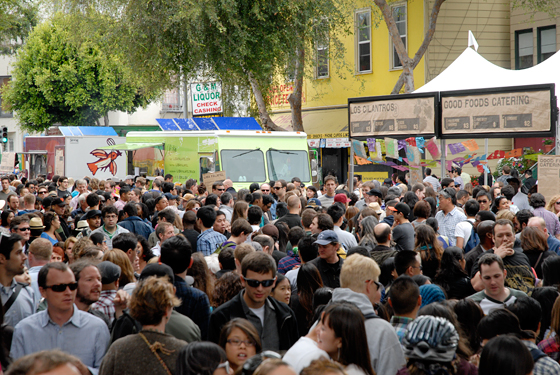
The crowds kept coming all day long. Did we mention the throng?
On occasions like these I'm grateful that media get a chance to sample early and first; methinks the same courtesy might be offered to neighborhood residents within a block or two of the event. Friends who live in spitting distance have never actually eaten at the festival; they've gotten too impatient and hungry to hang around.
The same was true around lunchtime on Saturday when a ravenous gang decided to ditch the moveable feast fare in favor of a regular restaurant on Valencia Street where good grub could be had without a wait. On the way some of us, saturated with salt early in the day and feeling thirsty, snagged agua frescas from savvy store owners and the unTwitterific street food vendors who set up modest tables or stands to catch the overflow crowd.
Talk about entrepreneurial spirit.
